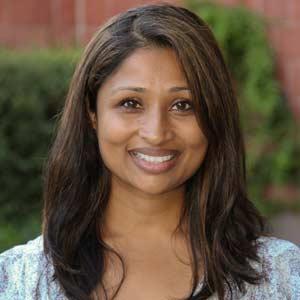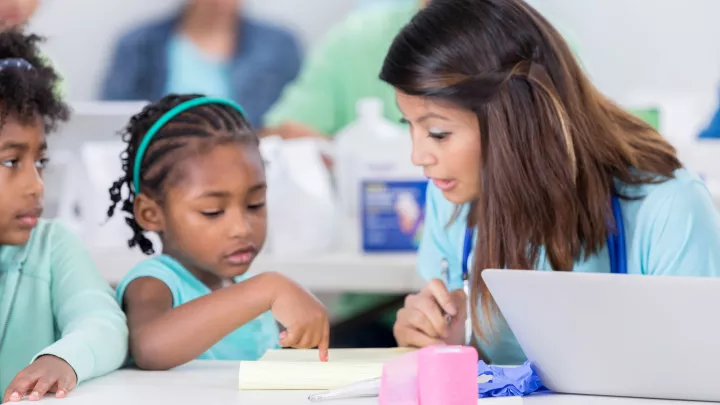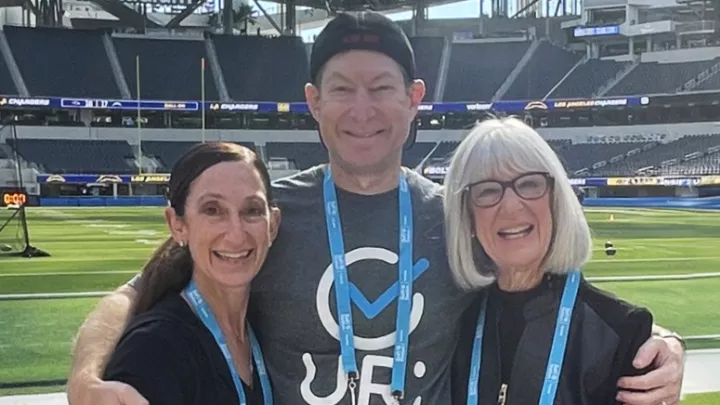
Community health workers gather together in front of the CHLA lettered blocks outside the hospital.
Community Health Workers Offer Hands-On Help to Medi-Cal Families
The stories stream from Mona Patel, MD, Attending Physician in the Division of General Pediatrics at Children’s Hospital Los Angeles. Each one tells of the extraordinary good being done by her team of community health workers (CHWs), the product of a benefit called Enhanced Care Management that makes their services available to families on Medi-Cal.
“Gosh, I have so many,” she says.
Here’s one of her favorites—the one about the bone marrow transplant patient whose family was in danger of having their power disconnected because their child’s condition kept them in the hospital and they fell behind on their bills. The community health worker called the Los Angeles Department of Water and Power (LADWP), helped the father fill out a form to explain the circumstances, and got the LADWP to write off some of the bills and help the family qualify for a reduced utility rate to keep the power on.
She offers up another, about a 17-year-old sickle cell patient at CHLA with complex emotional needs who receives daily calls from a community health worker, and in each call is read a poem. “Just that human touch,” Dr. Patel, President and Interim CEO of the CHLA Medical Group, says of the community health worker’s role. “Just that friendship, and that trust building.”
The attention paid by the CHW has had a transformative impact on the patient. “He’s showing up for his appointments, he’s taking his medications, he’s trusting us with his care,” she says.
“It’s not rocket science. It’s advocating. It’s just being there to help them along the way.”
Calling all Medi-Cal recipients!
Close to 75% of CHLA patient families are Medi-Cal beneficiaries, so Dr. Patel and her team are working to increase awareness about this troop of community health workers available to them as part of Enhanced Care Management, a benefit established in 2022 through the California Advancing and Innovating Medi-Cal (CalAIM) program. In spring 2023, CHLA created the Integrated Delivery Systems Department to administer the benefit, and Dr. Patel was named Chief of the department.

By the program’s definition, community health workers “help to coordinate care and services for patients and their families at the hospital and in the community.” In practice, coordinate care and services takes many forms, generally serving health-related social needs that require hands-on support outside the hospital walls.
“It’s anything,” she says. “It’s enrolling in benefits, it’s teaching how to eat healthy, it’s going with the family to the farmer’s market, it’s finding them transportation to appointments. It’s whatever is needed, whatever struggles families are facing.”
Dr. Patel says the CHWs are a perfect complement to the hospital’s clinical care. “We see very vulnerable populations that have teams of people who see them—doctors, nurses, therapists and beyond. What we have not always done as effectively is address the social-emotional components of health. How do we deliver our level of care out in the community? That’s really the heart of this program.”
Prior to the creation of Enhanced Care Management, if a family had health-related social needs, such as being without housing or suffering from food insecurity, CHLA’s social workers would come to their aid, directing them to resources that could help, but they didn’t have enough staff to reach families outside the hospital.
“We haven’t had the bandwidth to follow up,” Dr. Patel says, “to go with the family to the farmer’s market, help them enroll at the college, make sure they’re at their home when the food delivery package arrives. Nor have we had the depth of trust or community expertise.”
This is where the crew of 16 community health workers (Dr. Patel hopes to get to an even 20) has stepped in, allowing CHLA to screen more actively to identify families with these needs.
“If I find there’s a need, I introduce the community health worker, and they talk about the program and ask, ‘Is there anything I can help you with?’ And the families are so appreciative that CHLA cares in this way. They’re saying, ‘Thank you, first of all, for even asking.’”
A background in lived experience
The criteria for being a community health worker, as drawn up by the state, are unique. The minimum requirements aren’t academic, but rather experiential: 4,600 hours of lived experience. Lived experience covers a lot of ground, but the intention is to have people in the job who have shared the predicaments and crises that families on Medi-Cal often face.
Dr. Patel says this been-there-too quality creates an immediate closeness. “It’s different than me walking into a room and saying, ‘Hey, I see you have food insecurity,’ when in my life I might not have ever felt that. But to hear how to navigate that from someone who has experienced it, it creates a different level of trust.”
With the program more than a year old, Dr. Patel can put a number on its impact. “We’ve served about 2,000 encounters—individual family touches, we call them. We know the data: If you improve social-emotional well-being, that’s going to automatically improve health outcomes.”
She tells one last anecdote from the field—“I think the best one,” she says. Recently immigrated, the father of a CHLA liver transplant patient had a court case in Texas and was without food or housing. A community health worker got him an appointment at the local immigration rights organization, spent an entire Friday afternoon by his side as his advocate, and afterward got him a lawyer, a follow-up appointment, and emergency food and housing.
“The person at the organization said, ‘Are you the brother?’” Dr. Patel recounts. “And he said, ‘No, no. I’m from CHLA. I’m a community health worker and I’m helping him.’ They were like, ‘Wow, I can’t believe CHLA does this.’
“The workforce we’ve been able to hire through this program are actually doing these things with the families,” she says. “I think it’s such a beautiful way to deliver care. It’s deep social impact, in that it’s really lifting a population. And if you think about reducing health disparities, I mean, man, this is it.”


